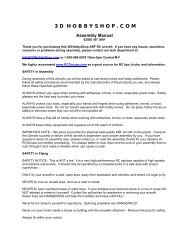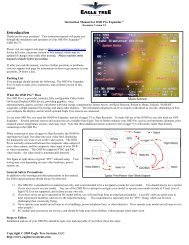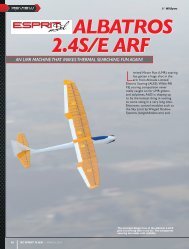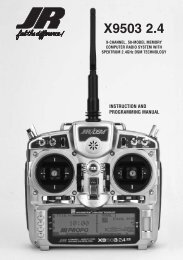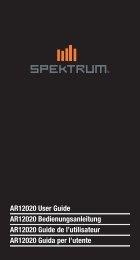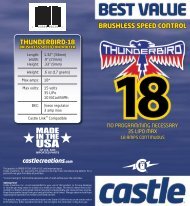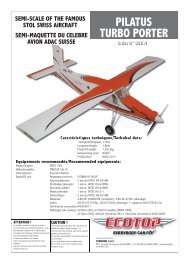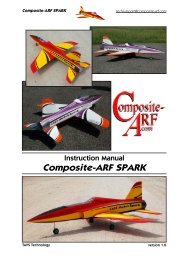DeNight Special 50 Manual - CMC Versand
DeNight Special 50 Manual - CMC Versand
DeNight Special 50 Manual - CMC Versand
Create successful ePaper yourself
Turn your PDF publications into a flip-book with our unique Google optimized e-Paper software.
Safety Do’s and Don’ts for Pilots<br />
● Ensure your batteries have been properly<br />
charged prior to your initial flight.<br />
● Keep track of the time the system is turned on so<br />
you will know how long you can safely operate your<br />
system.<br />
● Perform a ground range check prior to the initial<br />
flight of the day. See the “Daily Flight Checks<br />
Section” for information.<br />
● Check all control surfaces prior to each takeoff.<br />
● Do not fly your model near spectators, parking<br />
areas or any other area that could result in injury to<br />
people or damage of property.<br />
● Do not fly during adverse weather conditions. Poor<br />
visibility can cause disorientation and loss of control<br />
of your aircraft. Strong winds can cause similar<br />
problems.<br />
● Do not point the transmitter antenna directly toward<br />
the model. The radiation pattern from the tip of the<br />
antenna is inherently low.<br />
● Do not take chances. If at any time during flight<br />
you observe any erratic or abnormal operation, land<br />
immediately and do not resume flight until the<br />
cause of the problem has been ascertained and<br />
corrected. Safety can never be taken lightly.<br />
Dual Rate Recommendations<br />
● We recommend that the rudder dual rate be set to<br />
Low for takeoff to help minimize overcorrection<br />
during the takeoff roll.<br />
● We recommend the rudder dual rate be set to High<br />
for landing to help maintain heading as the model<br />
transitions from flying speed to taxi speeds.<br />
● Elevator and Aileron dual rates should be adjusted<br />
for personal feel and also if there are any unusual<br />
wind conditions.<br />
Age Requirements<br />
Age Recommendation: 14 years or over. This is<br />
not a toy. This product is not intended for use by<br />
children without direct adult supervision.<br />
Daily Flight Checks<br />
Step 1<br />
Check the battery voltage on both the transmitter and<br />
the receiver battery packs. Do not fly below 9.5V on<br />
the transmitter if you are using a JR or Spektrum<br />
transmitter that uses 8-cells to power the transmitter.<br />
Do not fly if the receiver pack is at or below 4.7V. To<br />
do so can crash your aircraft.<br />
Note: When you check these batteries, ensure you<br />
have the polarity correct on your expanded scale<br />
voltmeter.<br />
Step 2<br />
Check all hardware (linkages, screws, nuts, and bolts)<br />
prior to each days flight. Be sure binding does not<br />
occur and that all parts are properly secured.<br />
Step 3<br />
Ensure all surfaces are moving in the proper manner.<br />
Step 4<br />
Perform a ground range check before each flying session.<br />
Step 5<br />
Prior to starting your aircraft, turn off your transmitter,<br />
then turn it back on. Do this each time you start your<br />
aircraft. If any critical switches are on without your<br />
knowledge, the transmitter alarm will warn you at this<br />
time.<br />
Step 6<br />
Check that all trim levers are in the proper location.<br />
Step 7<br />
All servo pigtails and switch harness plugs should be<br />
secured in the receiver. Make sure the switch moves<br />
freely in both directions.<br />
<strong>DeNight</strong> <strong>Special</strong> <strong>50</strong> ARF Assembly <strong>Manual</strong><br />
45


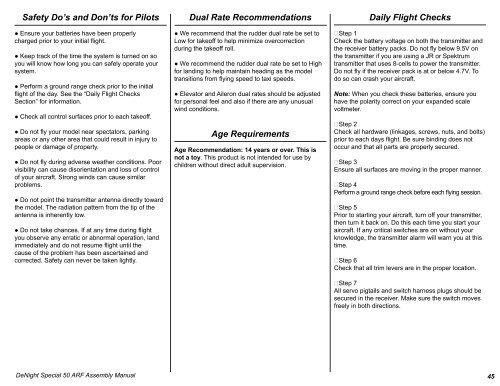
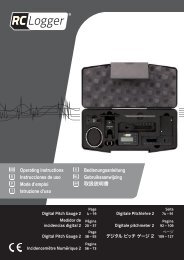
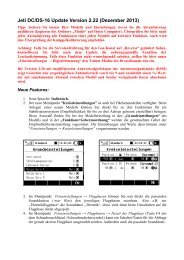

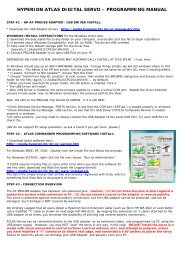
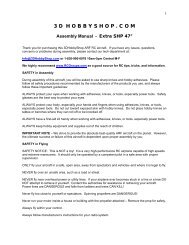
![P01(Oxalys EP) [更新済み].ai - Kyosho](https://img.yumpu.com/26948574/1/184x260/p01oxalys-ep-ai-kyosho.jpg?quality=85)
